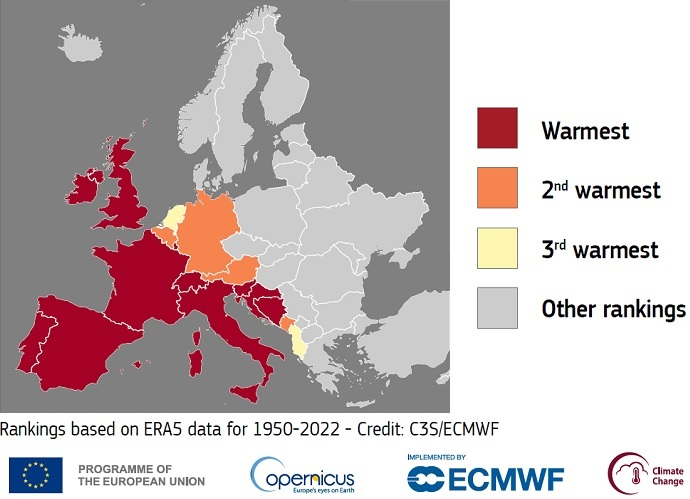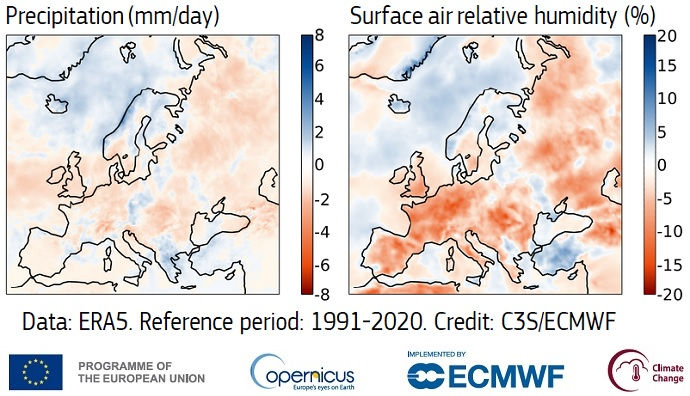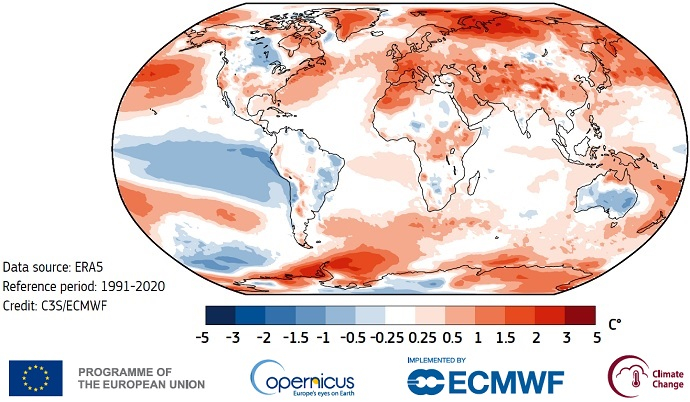

The year 2022 was the second warmest on record in Europe, and the summer of 2022 was the hottest in Europe, data released by the European Union’s Copernicus Climate Change Service (C3S) run by ECMWF show.
Persistent low levels of European rainfall, in combination with high temperatures and other factors, led to widespread drought conditions.
Globally, the year was the fifth warmest according to the ERA5 reanalysis, and the last eight years have been the eight warmest on record.
Atmospheric carbon dioxide concentrations increased at a similar rate to recent years, while methane concentrations increased more than average.
Second-warmest year in Europe
Temperatures in Europe across the year were the second warmest on record. 2022 was cooler than 2020 by 0.3°C, and marginally warmer – by around 0.1°C – than 2019, 2015 and 2014.
All of Europe, except for Iceland, saw annual temperatures above the 1991–2020 average. Temperatures were most above average in the western part of the continent.

Ranking of 2022 surface air temperatures by country over the period since 1950. Data source: ERA5. Credit: Copernicus Climate Change Service/ECMWF.
According to the C3S ERA5 dataset, several countries in western and southern Europe saw the highest annual temperatures since at least 1950.
Summer in Europe was the warmest on record by a clear margin, with the previous warmest summer in 2021.
Rainfall in Europe
The unusual warmth in late spring and summer in Europe, combined with a lack of rain, clear skies and dry soils, brought drought conditions especially to the southern and central parts of the continent.
Many countries reported impacts on agriculture, river transport and energy management. Extremely dry conditions also led to increased fire danger, resulting in unusually high fire activity in southwestern Europe, especially France and Spain.

Anomalies in precipitation and the relative humidity of surface air in Europe for the summer of 2022 (June to August) with respect to 1991–2020. Data source: ERA5. Credit: Copernicus Climate Change Service/ECMWF. Originally published in the August 2022 hydrological bulletin.
Fifth-warmest year globally
During 2022, the world experienced its fifth-warmest year on record, according to the C3S ERA5 dataset, but only by a very small margin. Other widely used temperature datasets are likely to rank 2022 slightly differently. So far, the hottest years on record globally are 2016, 2020, 2019 and 2017.

Air temperature at a height of two metres for 2022, shown relative to its 1991–2020 average. Source: ERA5. Credit: Copernicus Climate Change Service/ECMWF.
According to ERA5, the annual average temperature was 0.3°C above the reference period of 1991–2020, which equates to approximately 1.2°C higher than the period 1850–1900, typically used as a proxy for the pre-industrial era. This makes 2022 the eighth year in a row of temperatures more than 1°C above the pre-industrial level.

Annual averages of the estimated global surface temperature increase above the 1991–2020 (left-hand axis) and 1850–1900 (right-hand axis) reference levels. 2022 is according to ERA5 only, all other years according to six different datasets. Data sources: ERA5 (C3S/ECMWF), JRA-55 (JMA), GISTEMPv4 (NASA), HadCRUT5 (Met Office Hadley Centre), NOAAGlobalTempv5 (NOAA) and Berkeley Earth. Credit: Copernicus Climate Change Service/ECMWF.
Carbon dioxide and methane concentrations
Together with the EU’s Copernicus Atmosphere Monitoring Service (CAMS) run by ECMWF, C3S reveals that atmospheric greenhouse gases continued to increase in 2022.
Preliminary analysis of satellite data averaged over the whole atmospheric column shows that carbon dioxide concentrations rose by approximately 2.1 ppm, while methane rose by around 12 ppb. This resulted in an annual average for 2022 of approximately 417 ppm for carbon dioxide and 1,894 ppb for methane.
For both gases these are the highest concentrations from the satellite record. By including other records, they are the highest levels for over 2 million years for carbon dioxide and over 800,000 years for methane.
More information
More detailed information on these findings can be found on the C3S website.
The top image is an excerpt from the plot on air temperature at a height of two metres for 2022, shown relative to its 1991–2020 average. Source: ERA5. Credit: Copernicus Climate Change Service/ECMWF.
